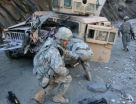(Press-News.org) Cambridge, Mass. – July 22, 2011 – Bioengineers at Harvard have identified, for the very first time, the mechanism for diffuse axonal injury and explained why cerebral vasospasm is more common in blast-induced brain injuries than in brain injuries typically suffered by civilians.
The research addresses two major aspects of traumatic brain injury (TBI), with significant implications for the medical treatment of soldiers wounded by explosions.
Two papers, published in the journals Proceedings of the National Academy of Sciences (PNAS) and PLoS One, provide the most comprehensive explanation to date of how mechanical forces can be translated into subtly disastrous physiological changes within the brain's neurons and vasculature.
"These results have been a long time coming," says principal investigator Kevin Kit Parker, a Professor of Bioengineering at Harvard's School of Engineering and Applied Sciences (SEAS) and a major in the U.S. Army. "So many young men and women are returning from military service with brain injuries, and we just don't know how to help them."
When the brain encounters a jarring force, such as an exploding roadside bomb, the delicate tissue slams against the skull. The result, if the patient survives, can be a temporary concussion, a more dangerous hemorrhage, or long-term TBI, which can even lead to the early onset of Parkinson's or Alzheimer's diseases.
Inspired by Parker's own military experience, the Disease Biophysics Group (based at SEAS and at the Wyss Institute for Biologically Inspired Engineering at Harvard) has taken up the cause. Using cutting-edge tissue engineering techniques—essentially creating a living brain on a chip—biologists, physicists, engineers, and materials scientists collaborate to study brain injury and potential targets for treatment.
Now, researchers in his group have identified the cellular mechanism that initiates diffuse axonal injury, offering urgently needed direction for research in therapeutic treatments.
Their studies show that integrins, receptor proteins embedded in the cell membrane, provide the crucial link between external forces and internal physiological changes.
Integrins connect the structural components within the cell (such as actin and other cytoskeletal proteins) with the extracellular matrix that binds cells together into tissue. Collectively, this network of structural and signaling components is referred to as the focal adhesion complex.
Parker's research has demonstrated that the forces unleashed by an explosion physically disrupt the structure of the focal adhesion complex, setting off a chain reaction of destructive molecular signals within the nerve cells of the brain.
Inside the neuron, integrins normally mediate the activation of the proteins RhoA and Rho kinase (ROCK). When the focal adhesion complex is disturbed, the Rho-ROCK signaling pathway goes haywire: it directs the motor protein actin to retract the cell's arm-like axons, disconnecting the neurons from each other and collapsing the cellular networks that constitute the brain.
"Our research has shown that abrupt mechanical forces, such as those from a blast wave and transduced by integrins, can result in neural injury," says Matthew A. Hemphill, who with Borna Dabiri (S.B. '07) and Sylvain Gabriele, is a lead author of the paper in PLoS One. Dabiri and Hemphill are currently graduate students at SEAS, and Gabriele is a former postdoctoral fellow in Parker's lab.
Adds Dabiri: "Encouragingly, we also found that treating the neural tissue with HA-1077, which is a ROCK inhibitor, within the first 10 minutes of injury, reduced the number of focal swellings. We think that further study of ROCK inhibition could lead to viable treatments within the near future."
A second direction of research in Parker's lab has solved another mystery in TBI, explaining why cerebral vasospasm, a dangerous remodeling of the brain's blood vessels, occurs more commonly in TBI caused by explosions than in other types of brain trauma.
"Until now, other researchers looking at TBI focused on ion channels and membrane poration, and it was generally accepted that cerebralvasospasm was only caused by hemorrhaging. It turns out that it's much morecomplicated than that," says Patrick W. Alford, a former postdoctoral fellow in Parker's lab and lead author of the paper in PNAS. "Integrins and Rho-ROCK signaling appear to be players in both diffuse axonal injury and cerebral vasospasm."
As reported in PNAS, the forces exerted on arteries are different during an explosive blast than during blunt force trauma. Subarachnoid hemorrhage, which can occur in very severe head injuries, is known to cause vasospasm, but Parker's new research shows that the unique force of an explosion can also cause vasospasm by itself.
The blast from an explosion creates a surge in blood pressure, which stretches the walls of the blood vessels in the brain. To study this, Parker's team of bioengineers built artificial arteries, made of living vascular cells, and used a specialized machine to rapidly stretch them, simulating an explosion. While this stretching did not overtly damage the cellular structure, it did cause an immediate hypersensitivity to the protein endothelin-1.
Endothelin-1 is known to stimulate vascular cells to absorb calcium ions, which affect actin—the same protein involved in the retraction of axons.
In the 24 hours following the simulated blast, the vascular tissues hypercontract and undergo a complete phenotypic switch, disrupting the overall function of the tissue. Both of these behaviors are characteristic of cerebral vasospasm.
Most importantly, as in the neural tissue, the Rho-ROCK signaling pathway plays an important role in the behavior of actin and the cells' contraction. Parker's team found that inhibition of Rho soon after the injury can mitigate the harmful effects of the blast on the brain's vascular system.
"We have established a toe-hold as we try to climb up on top of this problem," says Parker. "In many ways, this work is just the beginning."
INFORMATION:
Parker's coauthors on the paper in PLoS One are Hemphill, currently at the University of Mons in Belgium; Dabiri, who beganworking in Parker's lab as an undergraduate; Gabriele, who is now at the University of Mons; Lucas Kerscher, a visiting student; Christian Franck, formerly a postdoctoral fellow at SEAS and now at Brown University; Josue A. Goss, a staff engineer at SEAS; and Alford, who is now at the University ofMinnesota.
Parker's coauthors on the paper in PNAS are Alford; Dabiri; Goss; Hemphill; and Mark D. Brigham, a graduate student at SEAS.
The Disease Biophysics Group received financial support from the Defense Advanced Research Projects Agency (DARPA) Preventing Violent Explosive Neurologic Trauma (PREVENT) Program, the Department of Defense, and the Harvard School of Engineering and Applied Sciences (SEAS).
The researchers also gratefully acknowledge the use of facilities at the Harvard Center for Nanoscale Systems, a member of the National Nanotechnology Infrastructure Network (NNIN), which is funded by the National Science Foundation (NSF).
Photos are available upon request.
Harvard bioengineers identify the cellular mechanisms of traumatic brain injury
Findings offer new hope for treatment of TBI in veterans wounded by explosions
2011-07-25
ELSE PRESS RELEASES FROM THIS DATE:
PGA invests in minority golf opportunities
2011-07-25
Los Angeles, CA (JULY 22, 2011) Golf's storied history in the US has long been criticized for its lack of diversity, but the PGA has taken steps to improve minority participation and exposure to the game. Minority participation has increased with the popularity and success of Tiger Woods, and continues today with targeted efforts, say the authors of "Increasing Minority Golf Participation Through PGA Education Initiatives" in the open access journal SAGE Open.
One important step in the process included one of the Historically Black Colleges and Universities (HBCUs) being ...
IV fluids may reduce severity of kidney failure in kids with E. coli infection
2011-07-25
AUDIO:
Giving intravenous fluids to children infected with E.coli bacteria early in the course of infection appears to lower the odds of kidney failure, according to a new study from researchers...
Click here for more information.
Infection with E. coli bacteria can wreak havoc in children, leading to bloody diarrhea, fever and kidney failure.
But giving children intravenous fluids early in the course of an E. coli O157:H7 infection appears to lower the odds of developing ...
A*Star scientists discover how to combat hospital-acquired infections and life-threatening toxins
2011-07-25
A team of scientists from A*STAR's Institute of Molecular and Cell Biology (IMCB) has discovered the secret recipe for 'antidotes' that could neutralize the deadly plant toxin Ricin, widely feared for its bioterrorism potential, as well as the Pseudomonas exotoxin (PE) responsible for the tens of thousands of hospital-acquired infections in immune-compromised patients all over the world. The results of this first ever genome-wide study to understand how the Ricin and PE toxins attack cells may also be useful for designing more effective antidotes against Diphtheria and ...
Battle won against Asian tiger mosquito
2011-07-25
An experimental research carried out in Sant Cugat del Vallès and Rubí, coordinated by researchers from UAB, assessed the efficacy of a combination of strategies to reduce the population of tiger mosquitos (Aedes albopictus). The research began in February 2008. The research focused on monitoring eggs found in small experimental traps. Researchers observed that for the first time, the number of eggs diminished after applying the measures.
The strategies began with a visit to the affected areas, where owners were informed on prevention measures and told the importance ...
Drexel study: Misuse of pain medication is pathway to high-risk behaviors
2011-07-25
PHILADELPHIA (July 22, 2011)— A new study by researchers at Drexel University's School of Public Health suggests that abuse of prescription painkillers may be an important gateway to the use of injected drugs such as heroin, among people with a history of using both types of drugs. The study, published in the International Journal of Drug Policy, explores factors surrounding young injection drug users' initiation into the misuse of opioid drugs. Common factors identified in this group included a family history of drug misuse and receiving prescriptions for opioid drugs ...
Signaling molecule identified as essential for maintaining a balanced immune response
2011-07-25
(MEMPHIS, Tenn. – July 22, 2011) St. Jude Children's Research Hospital investigators have identified a signaling molecule that functions like a factory supervisor to ensure that the right mix of specialized T cells is available to fight infections and guard against autoimmune disease.
The research also showed the molecule, phosphatase MKP-1, is an important regulator of immune balance. Working in laboratory cell lines and mice with specially engineered immune systems, scientists demonstrated that MKP-1 serves as a bridge between the innate immune response that is the ...
World's largest sheep an international traveler
2011-07-25
NEW YORK (July 22, 2011)—A genetic study of the world's largest sheep species has revealed that the big-horned animals travel extensively across the moutainous borders of Afghanistan, Tajikistan, and China according to Wildlife Conservation Society researchers with the support of the U.S. Agency for International Development (USAID).
Using a non-invasive technique that extracts DNA from fecal samples, researchers in WCS's Afghanistan Program found that Marco Polo sheep in the Pamir Mountains of Afghanistan are genetically connected to sheep in neighboring Tajikistan and ...
Fool's gold gives scientists priceless insight into Earth's evolution
2011-07-25
Fool's gold is providing scientists with valuable insights into a turning point in the Earth's evolution, which took place billions of years ago.
Scientists are recreating ancient forms of the mineral pyrite – dubbed fool's gold for its metallic lustre – that reveal details of past geological events.
Detailed analysis of the mineral is giving fresh insight into the Earth before the Great Oxygenation Event, which took place 2.4 billion years ago. This was a time when oxygen released by early forms of bacteria gave rise to new forms of plant and animal life, transforming ...
Office of Naval Research's TechSolutions program lightens burden for Navy's EOD team
2011-07-25
ARLINGTON, Va. — Designed to cut the 50 pounds of battery devices hauled by the Navy's explosive ordnance disposal (EOD) teams, the Office of Naval Research's (ONR) TechSolutions Program has developed a lightweight power system, which was delivered July. 22.
Responding to a request from the Explosive Ordnance Disposal Training and Evaluation Unit (EODTEU) 2 to create a lightweight power device to charge their specialized equipment, TechSolutions partnered with Naval Surface Warfare Center Crane, Ind., and Protonex Technology Corp. to develop the Power Management Kit (PMK) ...
Deepwater Horizon crude less toxic to bird eggs after weathering at sea
2011-07-25
After collecting weathered crude oil from the Gulf of Mexico following the Deepwater Horizon oil spill, researchers at The Institute of Environmental and Human Health (TIEHH) at Texas Tech University have reported that only 8 to 9 percent coverage on the shells of fertilized mallard duck eggs resulted in a 50 percent mortality rate.
However, scientists also reported the amount of time the oil remained at sea and exposed to weather had a significant effect on its toxicity to the fertilized duck eggs, said Phil Smith, an associate professor at TIEHH. They published their ...
LAST 30 PRESS RELEASES:
If you're over 60 and playing with sex toys, you're not alone
Fame itself may be critical factor in shortening singers’ lives
Daily coffee drinking may slow biological ageing of people with major mental illness
New highly efficient material turns motion into power – without toxic lead
The DEVILS in the details: New research reveals how the cosmic landscape impacts the galaxy lifecycle
After nearly 100 years, scientists may have detected dark matter
Gender imbalance hinders equitable environmental governance, say UN scientists
Six University of Tennessee faculty among world’s most highly cited researchers
A type of immune cell could hold a key to preventing scar tissue buildup in wounds
Mountains as water towers: New research highlights warming differences between high and low elevations
University of Tennessee secures $1 million NSF grant to build semiconductor workforce pipeline
Biochar shows powerful potential to build cleaner and more sustainable cities worldwide
UT Health San Antonio leads $4 million study on glucagon hormone’s role in diabetes, obesity
65-year-old framework challenged by modern research
AI tool helps visually impaired users ‘feel’ where objects are in real time
Collaborating minds think alike, processing information in similar ways in a shared task
Routine first trimester ultrasounds lead to earlier detection of fetal anomalies
Royal recognition for university’s dementia work
It’s a bird, it’s a drone, it’s both: AI tech monitors turkey behavior
Bormioli Luigi renews LionGlass deal with Penn State after successful trial run
Are developers prepared to control super-intelligent AI?
A step toward practical photonic quantum neural networks
Study identifies target for disease hyper progression after immunotherapy in kidney cancer
Concordia researchers identify key marker linking coronary artery disease to cognitive decline
HER2-targeted therapy shows promising results in rare bile duct cancers
Metabolic roots of memory loss
Clinical outcomes and in-hospital mortality rate following heart valve replacements at a tertiary-care hospital
Too sick to socialize: How the brain and immune system promote staying in bed
Seal milk more refined than breast milk
Veterans with cardiometabolic conditions face significant risk of dying during extreme heat events
[Press-News.org] Harvard bioengineers identify the cellular mechanisms of traumatic brain injuryFindings offer new hope for treatment of TBI in veterans wounded by explosions


